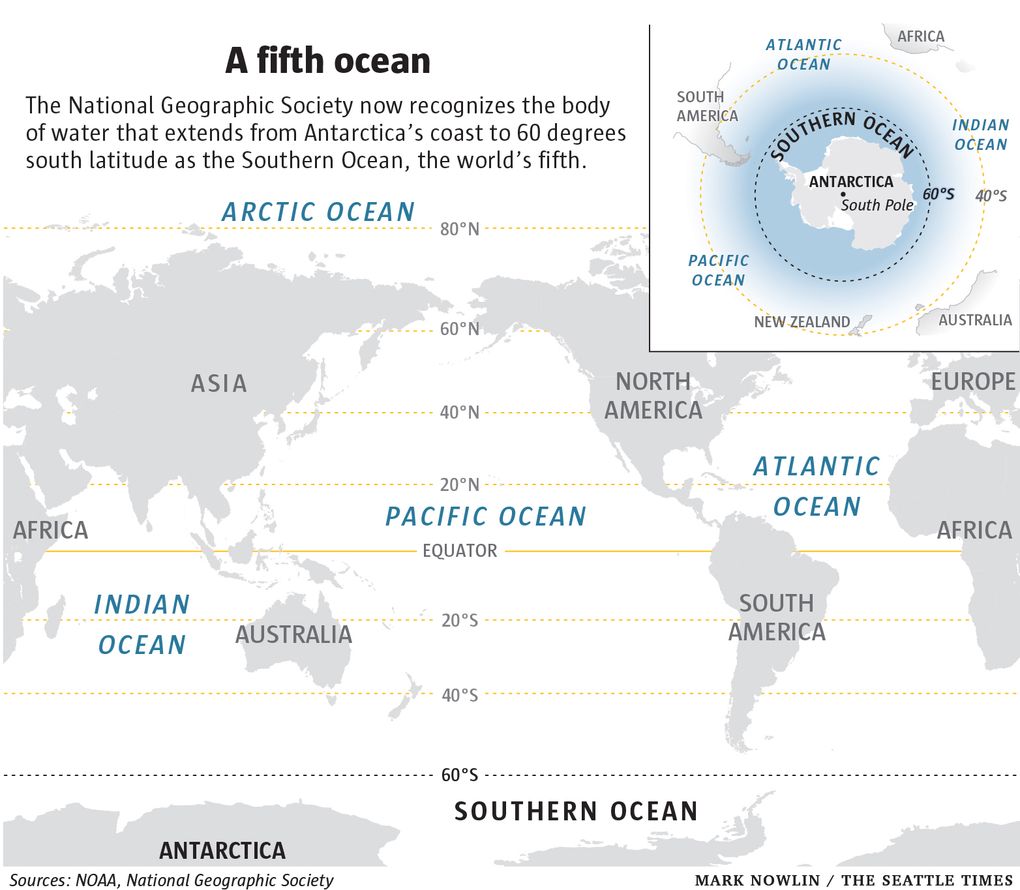On June 8, World Ocean day a renowned map-making group National Geographic mapped the fifth ocean officially called “Southern Ocean”.
The southern parts of the Indian, Pacific and Arctic oceans have always intrigued oceanographers and have been debated if that could be officially called an ocean.

Is this a new discovery?
It was first Proposed by IHO (International Hydrographic Organization) in 2000, but since all countries were not on the same page as to call it the Southern ocean or not it wasn’t officially named.
“The Southern Ocean has long been recognized by scientists, but because there was never agreement internationally, we never officially recognized it,” said Alex Tait, Geographer at National Geographic Society in a report.
Why name that now?
“We’ve always labeled it, but we labeled it slightly differently than other oceans. This change was taking the last step and saying we want to recognize it because of its ecological separation.”
We knew that it was different from other oceans. The stature of National Geography in map-making society adds more decree. And it aligns with initiatives to conserve oceans.
It is easy to raise awareness about something once it becomes official. And we know How big a project Ocean Conservation is.
This step focuses public awareness at a place in need of conservation.
Where is the Southern Ocean?
Earlier known as Gerlache strait, Southern Ocean is the water body surrounding Antarctica.
In the report published by National Geographic, the water surrounding Antarctica up to a northern limit at 60 degrees south latitude, excluding the scotia sea and the Drake Passage, is explained as the Southern Ocean.
This is also the limit of the United nations’ Antarctic Treaty.

What Makes it Different?
“Anyone who has been there will struggle to explain what’s so mesmerizing about it, but they’ll agree that the glaciers are bluer, the air colder, the mountains more intimidating, and the landscape more captivating than anywhere else you can go,” said marine scientist Seth Sykora-Bodie, a National Geographic explorer.
All the oceans are defined but the neighbouring continents but the southern ocean is defined by its current.
That current is ACC (Antarctic Circumpolar current) responsible for the global circulation system also known as the conveyor belt.
ACC circulates water more than any other ocean. It takes out water from the Atlantic, Pacific, and Indian Oceans and Circulates through the conveyor belt, which distributes heat around the planet.
ACC flows in broadband from west to east around Antarctica, roughly centered around 60-degree latitude of the south, same as the southern ocean. Water in ACC is colder and slightly less salty.
This cold and Dense water helps store carbon in the deep ocean. According to data, the Southern ocean is responsible for 40% of the world’s carbon uptake.
This tells us that Southern ocean has a crucial impact on Earth’s climate.
Flora and Fauna:
Southern Oceans have a different environment than other oceans, the water is colder, it’s less salty thus a lot of flora and fauna inhabit there and nowhere else.
It encompasses unique marine life ecosystems giving home to seals, penguins, humpback whales etc.
The impact of commercial fishing has been devastating to this ecosystem where some animals like humpback whales who eat krills and toothfish have to migrate.
This feat by National Geographic society will focus the attention of conservationists around the world.
Going There
- Polar Pod
Jean-Louis Etienne had announced recently that he developed a floating lab specifically designed to study the Southern Ocean.
That lab is called a Polar Pod. It works by circumpolar currents the same as satellites around Antarctica. It will allow data acquisition and observation over long distances.
Etienne hopes to finish and deploy the Polar Pod by 2024. However, the Southern Ocean is not yet empty.
- SOCCOM
Around 200 robotic floats, all equipped with sensors measuring the salinity, oxygen levels, chlorophyll, and other environmental data, were shipped into the sea from the Southern Ocean Carbon and Climate Monitors and Modeling project (SOCCOM), which is led by Princeton University.
Sources:
There’s a new ocean now—can you name all 5? (nationalgeographic.com)
National Geographic adds fifth ocean to world map | CNN Travel
There Is Now a Fifth Ocean on Earth (ign.com)
POLAR POD – Jean-Louis Etienne – Explorateur (oceanpolaire.org)














